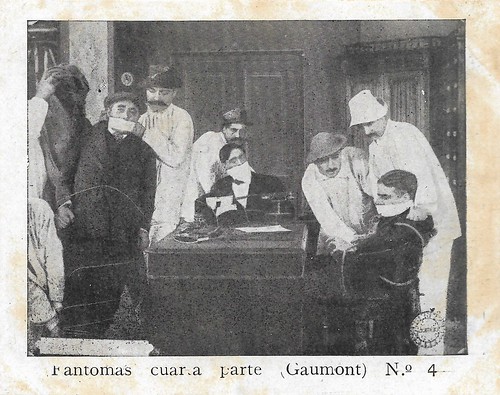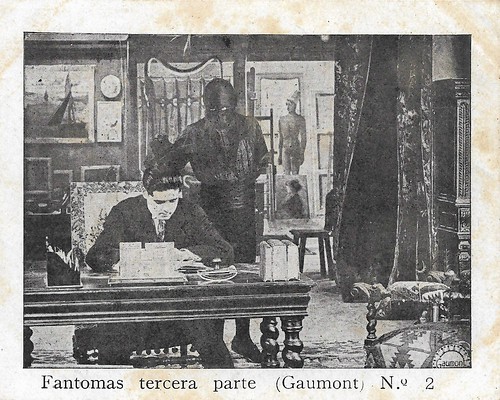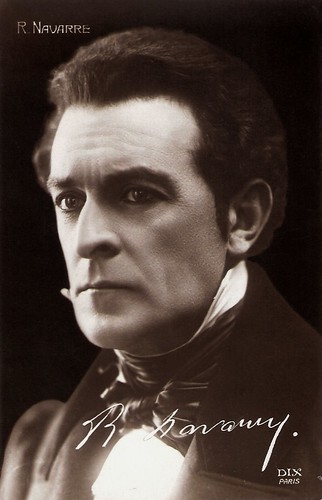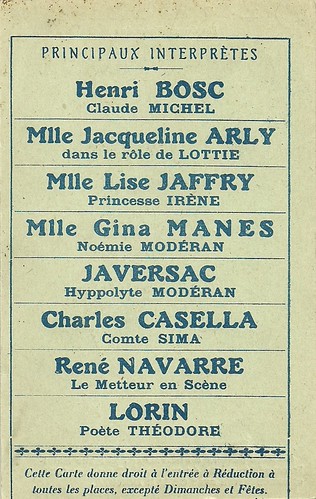Fantômas contre Fantômas (1914)

Spanish minicard by Reclam Films, Mallorca, card 1 of 6. Photo: Gaumont. Edmund Breon in Fantômas contre Fantômas (Louis Feuillade, 1914), the fourth episode of the serial Fantomas. Juve is falsely accused of being Fantomas and is arrested. Sitting on the right, the juge d'instruction Fuselier.

Spanish minicard by Reclam Films, Mallorca, card 2 of 6. Photo: Gaumont. Scene from Fantômas contre Fantômas (Louis Feuillade, 1914). During the charity ball given by Lady Beltham, three men show up as Man in Black - only one of them is the real Fantomas. The second is Fandor, the third - visible here at the police station - a police officer. On the right, we see the actor Maury, who plays the Head of the Sureté.

Spanish minicard by Reclam Films, Mallorca, card 3 of 6. Photo: Gaumont. René Navarre in Fantômas contre Fantômas (Louis Feuillade, Gaumont 1914). Fantomas presents himself to the police as the American private detective Tom Bob, while the police find the corps of the robbed bank messenger behind a newly made wall.
Fantômas contre Fantômas/Fantomas Against Fantomas (1914) opens with Fandor (Georges Melchior) overhearing other café customers talking about a newspaper item which speculates that Inspector Juve (Edmund Breon) and Fantômas are the same person and notes that Juve has been arrested as a "witness". Cut to the room of Père Moche (Fantômas in disguise, of course), where he is turning over rent receipts to a bank messenger. The messenger goes upstairs to collect the rent from Paulet and Nini, a pimp (it's implied) and his woman. When Nini opens the door (blocking the camera's view) Paulet smashes the messenger over the head with a hammer — we see only the messenger's body falling forward into their apartment after the impact. In the confusion, Père Moche sneaks upstairs, grabs the messenger's satchel, and returns to his office to put it in his safe. When Paulet and Nini confront him (Paulet attempts to stab him), Père Moche disarms Paulet and then offers to help them out of their predicament. Later, a new tenant is having her apartment partitioned because one of the rooms is too big. We see a new workman enter the room where the newly plastered wall has just been finished. He drives a nail into the wall — and blood runs out! The police are called, the wall is torn open and the bank messenger's body is revealed. When the workman is questioned he hands the police a calling card: he is "Tom Bob, Private Investigator, New York."
We then see "Tom Bob" visit Lady Beltham (Renée Carl), now married to a Duke. She recognises him as Gurn/Fantômas (René Navarre), and he compels her to write an announcement of a charity ball to raise funds to capture Fantômas. On the night of the ball, we see Fandor disguising himself as Fantômas in his Man in Black costume: black bodysuit and hood. Also, a policeman had the same idea. When Lady Beltham greets her guests she experiences consternation when she has to welcome two "Fantômases." And on their heels comes another Man in Black, whom she recognizes to her horror as the true Fantômas.
During the dancing, the policeman and the true Fantômas collide and go outside to settle the matter. Fandor follows at a distance. Suddenly Fantômas rushes back to get his cloak, wounded in the right arm. Fandor discovers the policeman's body with a knife protruding from its chest, but too late — Fantômas has escaped. The police chief realises that if Juve and Fantômas are the same person, the jailed Juve will be wounded on his right arm. The chief goes to the jail, where Juve is found drugged and, indeed, wounded on his right arm. On being awakened, he demands that they assemble the prison guards. Juve recognises the guard who drugged him, and a vial of narcotic and a bloody knife are found in the guard's pockets. Juve is cleared of suspicion of being Fantômas and is secretly released.
In some ruins on the outskirts of Paris Fandor discovers Père Moche and a gang of Apaches arguing over money. As Fandor watches from his hiding place Père Moche produces a letter from Fantômas to appease the gang, and they reluctantly leave. Then Père Moche pulls a strongbox from a nearby well and takes it into an abandoned building. Fandor follows and sees him pry up a flagstone and hide the strong box underneath it. Père Moche leaves the building, unknowingly locking Fandor inside. Cut to police headquarters where a group of workmen are filing through Juve's office to reach some scaffolding outside the window — when suddenly they attack Juve and tie him up. Juve is taken by the gang to the hideout, where Fandor has concealed himself in an empty wine cask. The gang dumps Juve next to the cask and starts arguing about what to do with him. Juve hears Fandor's voice coming from the cask, directing him to pretend to be Fantômas and reveal that the strongbox is hidden under the flagstone. The ruse works.
Meanwhile, Tom Bob is bringing the cops to Père Moche's hideout. The gang has outlived its usefulness, and Fantômas wants all the money for himself. Juve convinces the gang inside the hideout that the approaching cops are more Apaches in disguise. When the gang opens the door, they are all captured. But when Tom Bob spots Juve and Fandor, he slips away unnoticed. He goes to Lady Beltham's villa, where he demands the money collected in the charity ball subscription. As he leaves with the money, he's seized by Juve and Fandor. But Fantômas has one more trick up his sleeve. As Juve and Fandor walk on either side of him, holding his arms, he shoves them into concealed pits dug on either side of the footpath and escapes yet again.

Spanish minicard by Reclam Films, Mallorca, card 4 of 6. Photo: Gaumont. Scene from Fantômas contre Fantômas (Louis Feuillade, 1914). Fantomas' gang, dressed as workmen, tie up the policemen, including the juge d'instruction Fuselier, and kidnap Juve (Edmund Breon).

Spanish minicard by Reclam Films, Mallorca, card 5 of 6. Photo: Gaumont. Edmund Breon as Inspector Juve in Fantômas contre Fantômas (Louis Feuillade, 1914). The juge d'instruction Fuselier discovers Juve has the same wound as Fantomas. Afterward, it is discovered the corrupt guard Nibet, Fantomas's crony, set him up.

Spanish minicard by Reclam Films, Mallorca, card 6 of 6. Photo: Gaumont. Renée Carl as Lady Beltham and René Navarre as Fantomas in Fantômas contre Fantômas (Louis Feuillade, 1914). At Lady Beltham's villa, Fantomas demands the money collected in the charity ball subscription.
Le faux magistrat (1914)

Spanish minicard by Reclam Films, Mallorca, card 1 of 6. Photo: Gaumont. Scene from Le faux magistrat/The False Magistrate (Louis Feuillade, 1914), the fifth episode of the serial Fantomas. Pretending to be judge Pradier, Fantômas (René Navarre) orders the arrested gang members Paulet and L'Elève to make sure Juve will be killed.

Spanish minicard by Reclam Films, Mallorca, card 2 of 6. Photo: Gaumont. Scene from Le faux magistrat/The False Magistrate (Louis Feuillade, 1914). Ribonard (Martial) hides in the church bell. He cheats on Fantomas, keeping the stolen jewels for himself. He has strapped himself on the clapper with his suspenders. But when the bell is tolled, he is killed, causing a rain of jewels and blood to fall down the assembly. In the film, this picture has a horizontal format.

Spanish minicard by Reclam Films, Mallorca, card 3 of 6. Photo: Gaumont. Scene from Le faux magistrat/The False Magistrate (Louis Feuillade, 1914). Pradier/Fantomas (René Navarre) uses paper to make the hats fit of the murdered real Pradier. Fandor discovers this. and finds out Fantomas is after Juve travelling from Louvain to Saint-Calais - and thus, Juve is in danger. The close shot of the action on this card is not visible in the restored print of the film - only a long shot of the action is visible.
In Le faux magistrat/The False Magistrate (Louis Feuillade, 1914), the Marquis de Tergall (Mesnery) decides to sell his wife's jewels to pay his debts. His eavesdropping maid Rosa (Suzanne Le Bret) overhears the Marquis setting up a meeting with a jeweller the next day in Room 30 of the Saint-Calais Hotel. As the Marquis arrives with the jewels in Room 30 at the appointed hour, he sees a priest leaving Room 29 next door. The jeweller arrives and produces a check for 250,000 francs. The Marquis is displeased — he wants cash. The jeweller invites him to cash the check at his bank, just five minutes away. In the meantime, the jeweller places the box containing the gems in a drawer in a bureau. When the Marquis returns, cash in hand, and passing another priest coming out of room 29, the meeting seems to have concluded— until the jeweller reaches into the drawer, opens the jewel box, and finds it empty. He accuses the Marquis and calls the police.
When Room 29 is searched a hole in the wall connecting to Room 30 is discovered, and the bureau also has a hole in the back. While these discoveries are being made, the true priest who lives in Room 29 comes in and immediately falls under suspicion. He is cleared when two women show up carrying a bundle of priests' vestments that had been thrown from a train leaving Saint-Calais. Since it is now clear that neither the priest nor the Marquis was involved, the Marquis mounts his bicycle [!] and decides to take a shortcut home through the woods. But he doesn't notice the rope stretched across the trail and is knocked to the ground. Two apaches, Ribonard (Jean-François Martial) and Paulet - in other sources he is called Bébé - (Laurent Morléas), rush out of the bushes and rob him of the 250,000 francs. The Marquis' maid Rosa, Paulet's friend, keeps the stolen money.
1. Le Prisonnier de Louvain (The Prisoner of Leuven)
Cut to Juve telling Fandor that Fantômas is in jail in Belgium. (You may remember that at the end of the previous film, Fantômas contre Fantômas, Fantômas had escaped. But Feuillade did not adapt books seven through eleven, and in the eleventh novel, 'L'arrestation de Fantômas' (The arrest of Fantômas), Fantômas had finally been captured by Juve and Fandor — but in Belgium, where there is no death penalty.) Juve tells Fandor of his plan to spring Fantômas from jail in Belgium so that he can be rearrested in France and finally executed for his crimes. Juve's plan involves substituting himself for Fantômas (not the first time in the series that they've switched roles). The exchange takes place, and Fantômas, dressed in a smuggled guard's uniform, walks out of the prison unchallenged and is immediately tailed by two French policemen. We get to see Navarre and the policemen walking outside the Louvain prison, through the city centre of Louvain (Place du Vieux-Marché), and at its railway station. This was just a few months before the German army would burn down the city centre, although the railway station and the prison still exist today.
2. Monsieur Pradier, juge d'instruction (Mr. Pradier, investigating judge)
After a change of clothes, Fantômas takes a train for Paris, but while stretching his legs at a way station, he spots the detectives. He shakes them by re-entering his compartment but passing through the train and out the other side into the baggage car of a train on the next track. A passenger on the second train, a judge named Charles Pradier who is travelling to his new posting at Saint-Calais, is stretching his legs on the platform. The train begins to move before he can return to his compartment, and he jumps into the baggage car as it pulls out. Fantômas spots an opportunity and murders Pradier, flinging his body out of the moving train as it passes over a river; there's a gruesome shot of Pradier's hand as if grasping for life, slowly slipping under the water. Fantômas presents himself in Saint-Calais as the new judge Pradier.
3. Le Magistrat cambrioleur (The Burglar Magistrate)
One of the fake Pradier's first cases is the theft of the jewels and the robbery of the Marquis. Realising that his men are holding out on him, Fantômas appears to Paulet and Ribonard and demands that they turn over the jewels, or else. Meanwhile, the false Pradier has been invited to a hunting party at the Marquis's chateau. While there, he intercepts a compromising letter from the Marquise intended for another of the guests. The letter hints that the obstacles between the lovers will soon disappear. Feeling ill, the Marquis retires to his room to take a nap; the Marquise lights his gas fire and returns to the guests. But Pradier/Fantômas closes the gas cock, extinguishing the fire, then reopens it, filling the room with gas and suffocating the Marquis as he sleeps. Pradier/Fantômas blackmails the Marquise with the compromising letter for 500,000 francs; if she doesn't pay, she'll be accused of murdering the Marquis herself.
Fantômas meets Ribonard at the church, where the jewel box has been hidden in the bell. Fantômas holds the ladder while Ribonard climbs up into the bell and throws down the jewel box—then he kicks the ladder over, stranding Ribonard on the large clapper. (In an unseen shot, Ribonard must then strap himself to the clapper with his suspenders for safety.) Fantômas later discovers that the box is empty - he's been double-crossed. But he can't confront Ribonard, because he has to attend the funeral of the Marquis. When the bell is tolled at the funeral, Ribonard, still clinging to the clapper, is smashed against its sides and killed. As his lifeless body swings back and forth, "a rain of pearls, diamonds, rubies, and blood fell on the assembly" (as the intertitles put it). Pradier/Fantômas alertly gathers up the scattered jewels, "as evidence."
4. L'Extradé de Louvain (The Extradite of Leuven)
Fandor, alarmed by the events at Saint-Calais, arrives and stays at the same hotel as Pradier/Fantômas. He accidentally knocks his hat off the hatrack one day and notices that the brim is stuffed with paper. His suspicions are raised further when the dying Ribonard is cut down from the bell and whispers "Fantômas!" before expiring. On this basis, Juve (still believed by his Belgian jailers to be Fantômas) is extradited to France for the investigation. Pradier/Fantômas, realising that the net is closing in, frees two of his Apaches from jail, Paulet and L'Elève, and sends them to kill Juve when he arrives by train. Meanwhile, he pushes the Marquise to pay him his 500.000 and finds out the maid is carrying the money stolen from the Marquis, pressing her to give it all to him and having her arrested. But when the cronies ambush the prisoner, he turns out instead to be Fandor. Expecting an attack, he and his "guards" quickly subdue the Apaches, and Pradier/Fantômas is forced to sign an order returning his henchmen to jail. Since he'd just signed for their release, the suspicions of Fandor, the police and the gendarmes are confirmed.
The Marquise brings Pradier his money. When the 'prisoner from Louvain' is brought in, Navarre recognises Juve and knows he has to run. Yet, he is too late. Juve and Fandor have convinced the prosecutor Bernady to seal the building, and when Pradier/Fantômas tries to leave his office he is stopped by the police. Realising he's moments away from capture, Pradier/Fantômas writes an order and gives it to the head of the prison guard, telling him to keep it secret and follow it precisely. The man agrees and leaves as Juve and Fandor burst in. But Fantômas seems remarkably unphased, even as he's taken away in chains. And when Juve and Fandor go to the jail the next day, they discover why: Fantômas was released at midnight — on orders from Judge Pradier! "The prisoner is really Juve, not Fantômas, and has been arrested as a ruse." Once again, Fantômas has escaped, and the citizens of France must rest uneasily in their beds.

Spanish minicard by Reclam Films, Mallorca, card 4 of 6. Photo: Gaumont. Scene from Le faux magistrat/The False Magistrate (Louis Feuillade, 1914). After the hunting party, the guests of the Marquis de Tergall and his wife (Germaine Pelisse) don't know yet, that judge Pradier alias Fantomas (René Navarre) has gassed the Marquis.

Spanish minicard by Reclam Films, Mallorca, card 5 of 6. Photo: Gaumont. Scene from Le faux magistrat/The False Magistrate (Louis Feuillade, 1914). Fantomas (René Navarre), dressed as judge Pradier, blackmails the newly widowed Marquise (Germaine Pelisse).

Spanish minicard by Reclam Films, Mallorca, card 6 of 6. Photo: Gaumont. Scene from Le faux magistrat/The False Magistrate (Louis Feuillade, 1914). Juve (Edmund Breon) and Fandor (Georges Melchior) think they have finally caught Fantomas (René Navarre), but he will escape once more. This image, showing Fantomas in prison, the existing restored print lacks. It finishes with the showing of the release letter.
Sources: Robin Walz (Fantomas Lives) and IMDb.





















